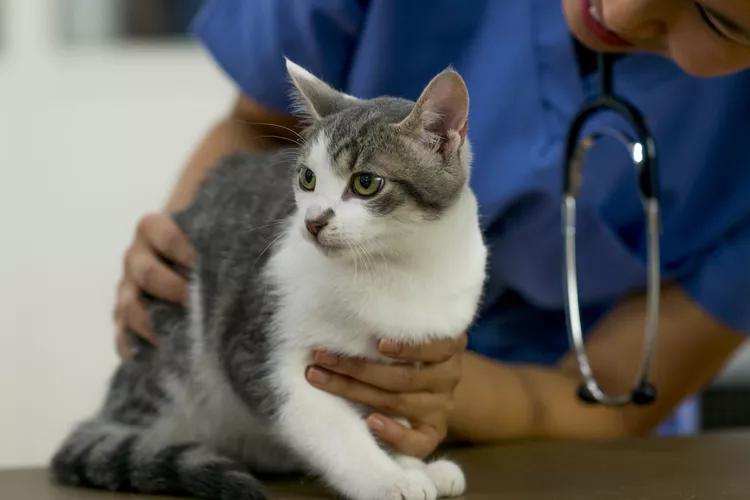
Feral cats (another name for homeless cats who have lived their entire lives outside) are born in the wild, and thus, have had very little contact with humans. Many animal lovers who find themselves in contact with a feral cat wonder if they can be domesticated, trained, and ultimately welcomed into their home as a pet, particularly if you’ve discovered a cat living outdoors in either cold weather, or a heavily trafficked and/or potentially unsafe environment.
The good news is that, yes, feral cats can become your new live-in feline friend. But there are several very important steps you must take first. Domesticating a feral cat is certainly not a task for the faint of heart and will require an enormous amount of time and patience.
Whether it found its way into your yard or you frequently spot a particular homeless cat lurking around your neighborhood, if you somehow find yourself in the company of a feral cat, there are some steps you can take to ensure both your safety, as well as the kitty’s. Keep in mind that because these cats have never had the pleasure of bonding with a human in any meaningful way, they often consider all people as large predators and are generally not afraid to act accordingly by biting, hissing, or even scratching or otherwise attacking you.
You should also never approach a cat that seems sick, even though you likely want to do everything in your power to help the poor kitty. If a feral cat has randomly shown up at your back door, there’s a decent chance he or she has rabies, and it’s far safer to call local animal control and avoid the risk of being bitten or scratched and requiring medical attention.
Above all, anyone who considers taming a feral cat must know that it will likely take several weeks—or even longer if you’ve found a particularly skittish kitty—so patience is of utmost importance.
Several factors will determine your ability to tame a feral cat, including the age and personality of the cat, as well as the kinds of experiences the cat has had on the street (as well as previous encounters they’ve had with other humans).
But there is one thing we humans have in our arsenal that will greatly increase your chances of training a feral cat—and that’s food. It’s widely understood that wild cats became domesticated in the first place because they became content with the idea of having access to regular meals, so if you’re thinking about taming a feral cat in your neighborhood, you’ll want to begin by establishing some sort of routine around food. For example, be sure to offer some cat food to the cat at the same time and in the same place every day, perhaps in a certain area on your porch or patio.
However, try not to make eye contact when you spot the cat (like dogs, eye contact can be perceived as a threat). Instead, remain still and quiet and either sit or stand quietly in the general vicinity while the kitty eats. After a few days, you can build up to speaking to your cat in a calm and reassuring voice.
If it seems like the cat is letting down its guard and beginning to trust you, try moving the food a little bit closer to you each day. You can also try offering a few special treats along with the meal. It’s important to keep in mind that you won’t want to touch the cat until you’re very confident that he or she will allow it. When you're ready to give it a go, try reaching out to pet the cat without making any sudden movements. If the cat backs away from your touch, give it a few days before trying again. Also, try letting the cat sniff your finger or the back of your cupped palm (with fingers bent inward to face yourself) beforehand. Eventually, you can gradually progress to petting the cat and even gently picking it up. However, remember to always wash your hands and arms thoroughly after handling any feral animals.
While the next step may seem like you can finally open your door to your new feline friend, you’ll want to avoid bringing it inside, particularly if you have other pets (or children). Instead, take the cat to the veterinarian to have a full checkup and vaccinations, as well as to be spayed or neutered (this will, of course, require the cat to trust you enough to put it into a crate for the trip). This step may take several attempts, but it’s absolutely essential for your health and safety, as well as your new cat’s.
If you have the all-clear from your vet and you're ready to welcome your new kitty home, you'll want to start with a special quiet, somewhat secluded space that's set aside just for the cat. Consider furnishing your cat's new living area with some cat trees, towers, and scratching posts, as well as places to hide and sleep. And, of course, don't forget the basics like a cat food and water bowl and a litter box. Fortunately, even cats who have spent their entire lives outdoors can generally grasp the concept pretty quickly.
Be sure to keep your interactions brief, until your new cat seems comfortable with its new surroundings. In time, your new cat should forget their days on the street and be more than content to relax and play at home with their new family.

75 Unisex Cat Names
Our gender neutral cat names perfect for your feline friend, with a diverse selection of fun and inclusive options to fit your pet's disposition.
Why Does My Cat Stink?
Is your cat stinky? Find out about the causes of bad odors in cats and when it is something to be concerned about. Learn how to help your stinky cat.
Signs of Rabies in Cats
Rabies is a fatal and contagious virus that can affect cats. Learn about the signs of rabies in cats and what to do about them.
Can Cats Eat Dog Food?
Can cats eat dog food? In small amounts, it's unlikely to be a problem, but long-term feeding of dog food to cats can cause health issues and malnutrition.
Exploring the Different Types of Pet-Friendly Beaches
Are you looking for pet-friendly beaches? Learn about the different types of pet-friendly beaches, their locations, and tips for visiting them with your pet.
Pulled Muscles in Dogs
A pulled muscle is one of the most common injuries seen in dogs. What can you do if your dog pulls a muscle and how can you prevent it?
Fibrosarcoma in Cats
Fibrosarcomas are potentially fatal soft tissue tumors that can occur in cats. Learn the causes, treatment, and prevention.
Alopecia in Dogs
Alopecia leads to hair loss and bald spots in dogs. Some breeds may be more at risk. Learn common causes, treatment, and prevention of dog alopecia.
Is Acetaminophen Safe for Dogs?
Acetaminophen is used by humans for pain and fever relief, but is it safe for dogs? Here's what you need to know before giving your dog acetaminophen.
Can Dogs Eat Almonds? Understanding the Risks and Guidelines
Can dogs eat almonds? While a couple likely won't hurt, it's best to avoid feeding your dog this nut. Learn the risks here.
Keeshond: Dog Breed Characteristics & Care
Learn about the keeshond dog, also known as the Dutch Barge Dog. This fluffy spitz breed was bred to guard, but also makes a friendly companion.
Is Rosemary Safe for Dogs?
Rosemary is used both for cooking and as a supplement with many reported health benefits in people, so you may be wondering if it is safe to give to your dog. Rosemary is considered non-toxic for dogs but with some caveats.
7 Hybrid Cats Breeds
Hybrid cat breeds can make appealing pets since they look more exotic than domestic house cats, but they aren't for everyone.
The Best White Cat Breeds to Keep as Pets
Several breeds can result in white cats with long or short hair. Find out the pros and cons of these white cat breeds.
11 Cute Pictures of Ragdoll Cats
Ragdoll cats are known for their beautiful coats and bright, blue eyes. Learn all about the breed, and check out some cute pictures here.
7 Reasons Why Your Cat Eats Paper, and How to Stop It
Is your cat eating paper? Learn why your cat is doing this, and find out how to put a stop to it.
Feist: Dog Breed Characteristics & Care
Feists are small, short-haired dogs developed to hunt squirrels and catch vermin. These high-energy, affectionate pooches make great companion animals.
Dogue de Bordeaux (French Mastiff): Dog Breed Characteristics & Care
Learn about the Dogue de Bordeaux, also called the French mastiff. Although large and muscular, they’re known for their calm and gentle personality.
How to Stop Your Dog From Fearing Men
Many dogs have a phobia of men. Learn how to help your dog overcome its fear through desensitization and training while keeping everyone safe.
Why Dogs Eat Poop and How to Stop Them
Is your dog eating poop? Some dogs do this because of stress or illness. Learn how to prevent stool eating, or coprophagia, in dogs.